包郵 原味精品書系EFFECTIVE C#(第3版):編寫高質(zhì)量C#代碼的50條有效方法(英文版)
-
>
全國(guó)計(jì)算機(jī)等級(jí)考試最新真考題庫模擬考場(chǎng)及詳解·二級(jí)MSOffice高級(jí)應(yīng)用
-
>
決戰(zhàn)行測(cè)5000題(言語理解與表達(dá))
-
>
軟件性能測(cè)試.分析與調(diào)優(yōu)實(shí)踐之路
-
>
第一行代碼Android
-
>
JAVA持續(xù)交付
-
>
EXCEL最強(qiáng)教科書(完全版)(全彩印刷)
-
>
深度學(xué)習(xí)
原味精品書系EFFECTIVE C#(第3版):編寫高質(zhì)量C#代碼的50條有效方法(英文版) 版權(quán)信息
- ISBN:9787121342653
- 條形碼:9787121342653 ; 978-7-121-34265-3
- 裝幀:一般膠版紙
- 冊(cè)數(shù):暫無
- 重量:暫無
- 所屬分類:>
原味精品書系EFFECTIVE C#(第3版):編寫高質(zhì)量C#代碼的50條有效方法(英文版) 本書特色
本書的作者,也是.NET專家Bill Wanger給出我們50條利用C#優(yōu)點(diǎn)以及特性來寫出健壯的,高效的,易于維護(hù)的代碼的高效法則。同時(shí),本書也反映出了C#語言愈發(fā)高級(jí)的特性以及關(guān)于它的開發(fā)社區(qū)。本書同時(shí)也給出了大量新穎的方法讓你能夠?qū)懗龈咝Э煽康拇a。*的第三版囊括了一些泛型和一些其他的語言集成查詢(LINQ),還包括了對(duì)異常高級(jí)實(shí)踐這一新的章節(jié)。
原味精品書系EFFECTIVE C#(第3版):編寫高質(zhì)量C#代碼的50條有效方法(英文版) 內(nèi)容簡(jiǎn)介
本書的作者,也是.NET專家Bill Wanger給出我們50條利用C#優(yōu)點(diǎn)以及特性來寫出健壯的,高效的,易于維護(hù)的代碼的高效法則。同時(shí),本書也反映出了C#語言愈發(fā)不錯(cuò)的特性以及關(guān)于它的開發(fā)社區(qū)。本書同時(shí)也給出了大量新穎的方法讓你能夠?qū)懗龈咝Э煽康拇a。近期新的第三版囊括了一些泛型和一些其他的語言集成查詢(LINQ),還包括了對(duì)異常不錯(cuò)實(shí)踐這一新的章節(jié)。
原味精品書系EFFECTIVE C#(第3版):編寫高質(zhì)量C#代碼的50條有效方法(英文版) 目錄
Item 1: Prefer Implicitly Typed Local Variables ........................................................... 1
Item 2: Prefer readonly to const ..................................................................................... 7
Item 3: Prefer the is or as Operators to Casts ............................................................... 12
Item 4: Replace string.Format() with Interpolated Strings ........................................... 19
Item 5: Prefer FormattableString for Culture-Specific Strings .................................... 23
Item 6: Avoid String-ly Typed APIs ............................................................................ 26
Item 7: Express Callbacks with Delegates ................................................................... 28
Item 8: Use the Null Conditional Operator for Event Invocations ............................... 31
Item 9: Minimize Boxing and Unboxing ..................................................................... 34
Item 10: Use the new Modifier Only to React to Base Class Updates ......................... 38
Chapter 2 .NET Resource Management .................................................. 43
Item 11: Understand .NET Resource Management ...................................................... 43
Item 12: Prefer Member Initializers to Assignment Statements ................................... 48
Item 13: Use Proper Initialization for Static Class Members ....................................... 51
Item 14: Minimize Duplicate Initialization Logic ........................................................ 53
Item 15: Avoid Creating Unnecessary Objects ............................................................ 61
Item 16: Never Call Virtual Functions in Constructors ................................................ 65
Item 17: Implement the Standard Dispose Pattern ....................................................... 68
Chapter 3 Working with Generics ........................................................... 77
Item 18: Always Define Constraints That Are Minimal and Sufficient ....................... 79
Item 19: Specialize Generic Algorithms Using Runtime Type Checking .................... 85
Item 20: Implement Ordering Relations with IComparable<T> and IComparer<T> .. 92
Item 21: Always Create Generic Classes That Support Disposable Type Parameters . 98
Item 22: Support Generic Covariance and Contravariance ........................................ 101
Item 23: Use Delegates to Define Method Constraints on Type Parameters ............. 107
Item 24: Do Not Create Generic Specialization on Base Classes or Interfaces .......... 112
Item 25: Prefer Generic Methods Unless Type Parameters Are Instance Fields ....... 116
Item 26: Implement Classic Interfaces in Addition to Generic Interfaces ................. 120
Item 27: Augment Minimal Interface Contracts with Extension Methods ................ 126
Item 28: Consider Enhancing Constructed Types with Extension Methods .............. 130
Chapter 4 Working with LINQ .............................................................. 133
Item 29: Prefer Iterator Methods to Returning Collections ........................................ 133
Item 30: Prefer Query Syntax to Loops ...................................................................... 139
Item 31: Create Composable APIs for Sequences ...................................................... 144
Item 32: Decouple Iterations from Actions, Predicates, and Functions ..................... 151
Item 33: Generate Sequence Items as Requested ....................................................... 154
Item 34: Loosen Coupling by Using Function Parameters......................................... 157
Item 35: Never Overload Extension Methods ............................................................ 163
Item 36: Understand How Query Expressions Map to Method Calls ........................ 167
Item 37: Prefer Lazy Evaluation to Eager Evaluation in Queries .............................. 179
Item 38: Prefer Lambda Expressions to Methods ...................................................... 184
Item 39: Avoid Throwing Exceptions in Functions and Actions ............................... 188
Item 40: Distinguish Early from Deferred Execution ................................................ 191
Item 41: Avoid Capturing Expensive Resources ........................................................ 195
Item 42: Distinguish between IEnumerable and IQueryable Data Sources ............... 208
Item 43: Use Single() and First() to Enforce Semantic Expectations on Queries ...... 212
Item 44: Avoid Modifying Bound Variables .............................................................. 215
Chapter 5 Exception Practices ................................................................ 221
Item 45: Use Exceptions to Report Method Contract Failures ................................... 221
Item 46: Utilize using and try/finally for Resource Cleanup...................................... 225
Item 47: Create Complete Application-Specific Exception Classes .......................... 232
Item 48: Prefer the Strong Exception Guarantee ........................................................ 237
Item 49: Prefer Exception Filters to catch and re-throw ............................................ 245
Item 50: Leverage Side Effects in Exception Filters .................................................. 249
Index .......................................................................................................... 253
原味精品書系EFFECTIVE C#(第3版):編寫高質(zhì)量C#代碼的50條有效方法(英文版) 作者簡(jiǎn)介
Bill Wagner是世界上最著名的C#開發(fā)者之一,是ECMA C#標(biāo)準(zhǔn)委員會(huì)的成員。他是Humanitarian Toolbox的主席,連續(xù)11年被授予Mcrosoft Regional Director和.NET MVP榮譽(yù)稱號(hào),最近剛剛被委派到.NET基礎(chǔ)顧問理事會(huì)任職。
影印版,無譯者……………
- >
伊索寓言-世界文學(xué)名著典藏-全譯本
- >
企鵝口袋書系列·偉大的思想20:論自然選擇(英漢雙語)
- >
中國(guó)人在烏蘇里邊疆區(qū):歷史與人類學(xué)概述
- >
史學(xué)評(píng)論
- >
龍榆生:詞曲概論/大家小書
- >
詩經(jīng)-先民的歌唱
- >
朝聞道
- >
苦雨齋序跋文-周作人自編集
















